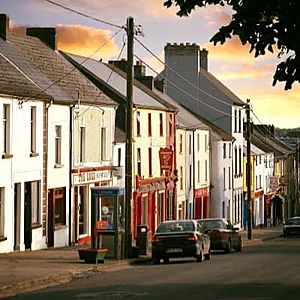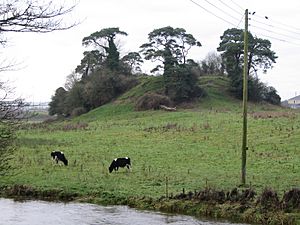Callan, County Kilkenny facts for kids
Quick facts for kids
Callan
Callainn
|
|
|---|---|
|
Town
|
|

Green Street, Callan, at sunset
|
|
| Country | Ireland |
| Province | Leinster |
| County | County Kilkenny |
| Area | |
| • Total | 5 km2 (2 sq mi) |
| Elevation | 65 m (213 ft) |
| Population
(2016)
|
2,475 |
| Irish Grid Reference | S410440 |
Callan (Irish: Callainn) is a town and civil parish in County Kilkenny, Ireland. It is about 16 km (10 mi) south of Kilkenny city. The town is close to the border with County Tipperary. Callan is the second largest town in County Kilkenny. In 2016, about 2,475 people lived there.
Contents
History of Callan
Callan was started by William the Marshal in 1207. It is believed that the town got its name from Niall Caille, a famous High King of Ireland.
The story goes that King Niall was fighting the Norsemen. He arrived in Callan to find the river was flooded. He saw his servant trying to cross the river and being swept away by the strong current. The King, known for being brave, rode his horse into the river to try and save his servant. But he was also pulled under and drowned by the fast water. The river is now called the "Kings River" because of this event.
Callan received its first special permission, called a charter, in 1217. This allowed the town to choose two members to represent it in Parliament.
In 1650, Oliver Cromwell and his army attacked Callan. Even though the main commander, Sir Richard Talbot, secretly planned to give up, some defenders refused. This led to a battle for the town. Many defenders and townspeople who hid in the stone castle and church were killed. Later, in the late 1800s, many human bones and cannonballs were found when the old church ruins were dug up.
A statue was put up outside the Church of the Assumption on Green Street. It remembers those from the Callan area who died during World War One.
In 2007, Callan celebrated its 800th birthday! President Mary McAleese helped launch the celebrations for the town's 800 years since it got its charter.
Places to See in Callan
Callan Motte, also known as "The Moat", is a very old mound of earth. It is located at the top of Moat Lane. It is one of the best-preserved Motte-and-bailey castles in Ireland. These were early types of castles built after the Normans arrived.
The Callan Augustinian Friary, often called the "Abbey Meadow", is in the north-east part of Callan. You can reach it from Bridge Street. The "Abbey Meadow" also has a holy well, which is a special spring or well.
St. Mary's Church is a medieval (very old) church on Green Street. A historic workhouse, which was a place where poor people lived and worked, is in an area called Prologue.
Education in Callan
Callan used to have two primary schools: Scoil Mhuire and Scoil Iognáid Rís. In 2007, these two schools joined together to form a new school called Bunscoil McAuley Rice.
The town also has two secondary schools for older students. There is Coláiste Éamann Rís for boys and St. Brigid's College for girls.
Famous People from Callan
Many notable people were born in or lived in Callan, including:
- Edmund or Edward Butler (died 1584) was a judge and an important lawyer for Ireland. He lived in Callan for most of his life.
- Gerald Comerford (died 1604) owned a lot of land in Callan in the late 1500s. He was also an important politician and judge. You can still see his tomb at St Mary's Church.
- Patrick Cudahy (1849–1919) was an American businessman and someone who gave money to good causes.
- James Hoban designed famous buildings like The White House in the USA and Leinster House in Ireland. He was born near Callan.
- Linda Hogan (born 1964) is a professor at Trinity College Dublin.
- Edmund Ignatius Rice started two religious groups, the Irish Christian Brothers and the Presentation Brothers.
- Thomas Kilroy is an Irish writer who wrote plays and novels.
- John Locke (1847–1889) was an Irish poet.
- Seamus Moore (singer) is an Irish singer and songwriter.
- Tony O'Malley was a well-known Irish painter.
- Amhlaoibh Ó Súilleabháin (1780–1838) was a schoolteacher and shop owner in Callan. He wrote a diary in the Irish language.
See also
In Spanish: Callan para niños





